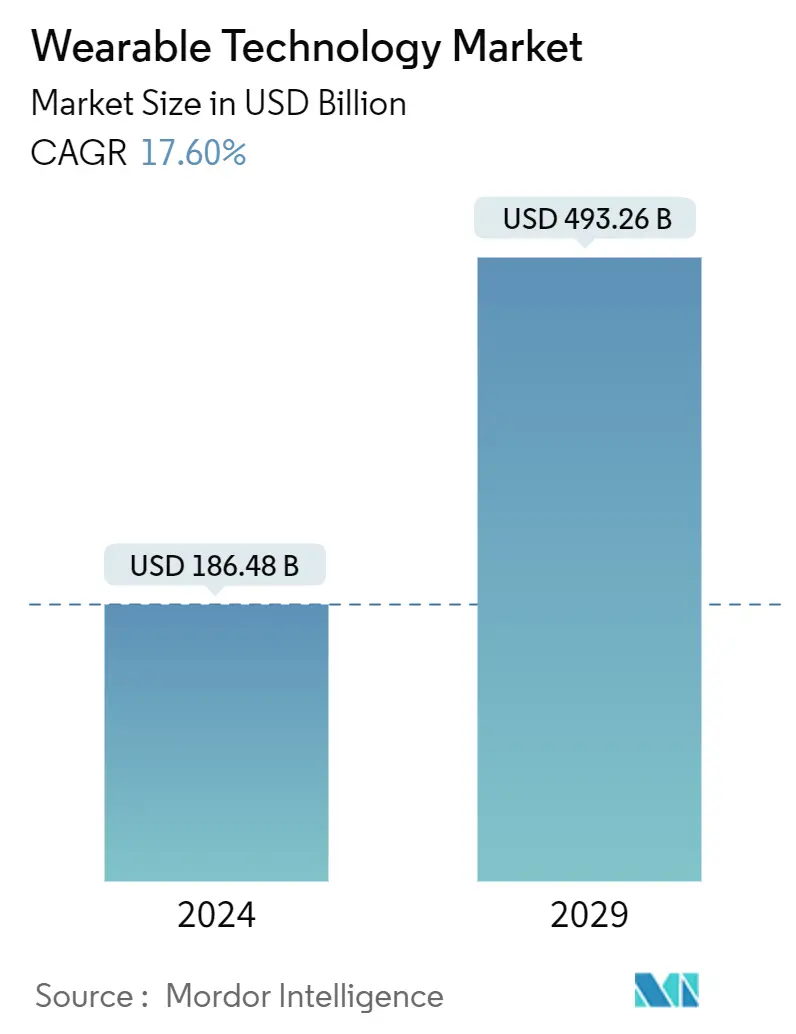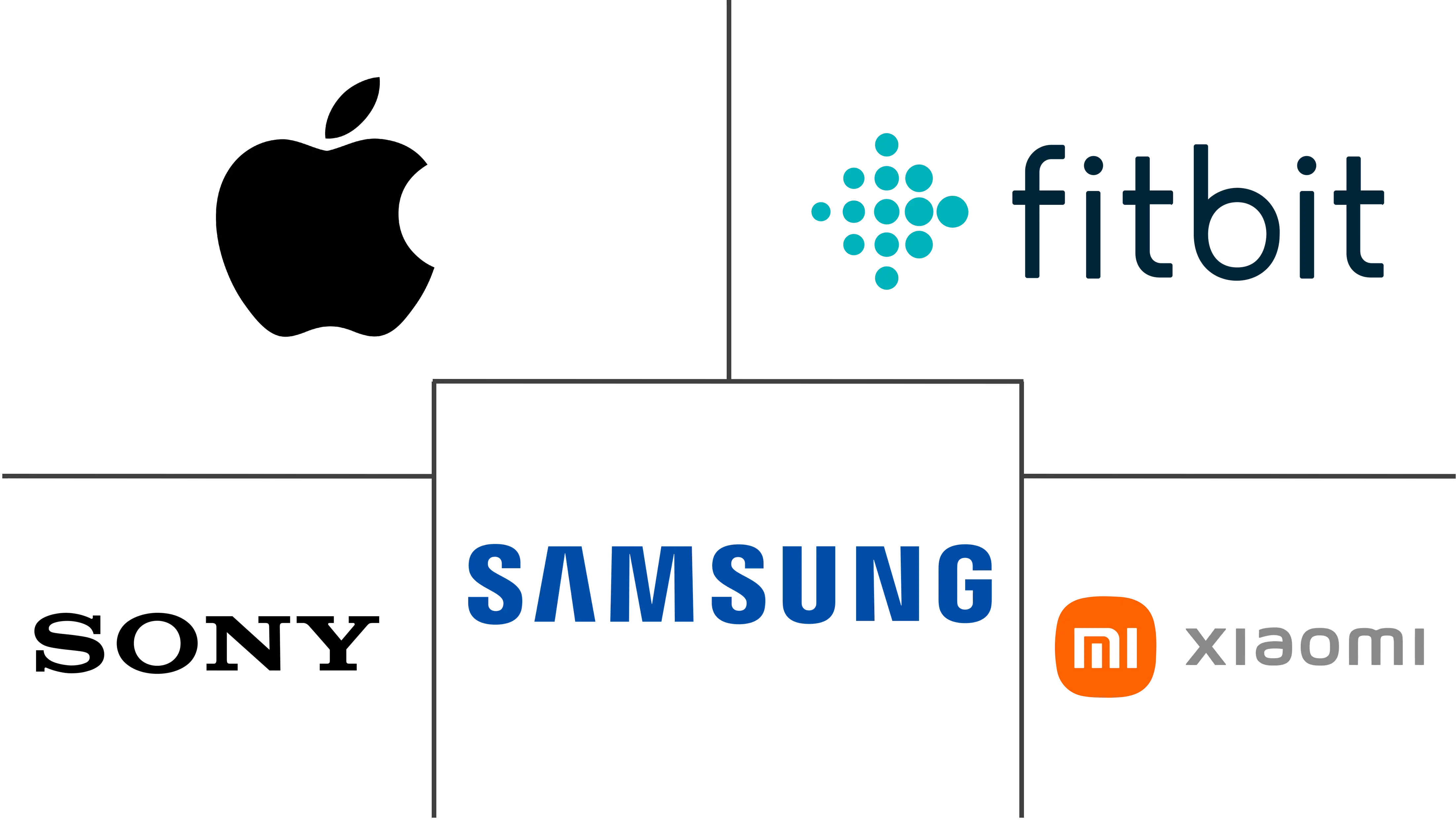Market Size of Wearable Technology Industry

| Study Period | 2019 - 2029 |
| Market Size (2024) | USD 186.48 Billion |
| Market Size (2029) | USD 493.26 Billion |
| CAGR (2024 - 2029) | 17.60 % |
| Fastest Growing Market | Asia Pacific |
| Largest Market | North America |
Major Players
*Disclaimer: Major Players sorted in no particular order |
Wearable Technology Market Analysis
The Wearable Technology Market size is estimated at USD 186.48 billion in 2024, and is expected to reach USD 493.26 billion by 2029, growing at a CAGR of 17.60% during the forecast period (2024-2029).
- The evolution of wearable technology is largely attributed to the rise of MEMS sensors. Wearable devices now integrate these sensors, particularly in response to the widespread use of smartphones, which heavily rely on GPS and IMU (comprising an accelerometer, gyroscope, and magnetometer). This integration has significantly enhanced the capabilities of fitness-tracking wearables, enabling them to closely monitor various body activities.
- Technological advancements in consumerism have led to the rise of wearable technology that monitors health, tracks movements, and provides social media notifications. Devices such as smartwatches, fitness trackers, and VR/AR headsets are becoming increasingly prevalent among the population. Consequently, the popularity of wearables is expected to continue growing, prompting companies to find innovative ways to integrate them into daily life.
- Smart clothing is experiencing a significant increase in demand, particularly within the wearable technology market, and is set to transform the health and fitness industry. Known as e-textiles or smart fabrics, these garments incorporate advanced sensors, hardware, and textiles, providing personalized insights and monitoring capabilities that surpass traditional clothing. With their ability to track the wearer's activity, sleep patterns, and health indicators such as heart rate, blood pressure, and body temperature, the market is expected to see substantial growth over the forecast period.
- However, the rapid adoption of wearable technology has highlighted significant ethical and privacy concerns, particularly in managing and protecting personal health data, which challenges the market’s growth. For example, a recent incident involved an unsecured database containing over 61 million records related to fitness trackers and wearables, exposing data of Apple and Fitbit users online. WebsitePlanet and security researchers discovered this non-password-protected database, which contained tens of millions of records from fitness tracking and wearable devices and apps. The unsecured database belonged to GetHealth, a company that provides a unified solution to access health and wellness data from hundreds of wearables, medical devices, and apps.
- The wearable technology market experienced a mixed impact from the COVID-19 pandemic. On the positive side, demand for health-focused wearables, such as fitness trackers and smartwatches, increased as consumers sought to monitor vital signs and sleep patterns, reflecting a heightened focus on personal well-being. Wearables also played a significant role in remote patient monitoring, reducing the strain on hospitals. However, lockdowns disrupted production and supply chains, affecting product availability. The economic slowdown also led some consumers to prioritize essential purchases over wearables.
- In the post-pandemic era, the market has rebounded due to increased health awareness and the continued growth of remote patient monitoring. Advancements in wearables with features like blood pressure monitoring and fall detection are expected to see high demand, solidifying wearables as valuable tools in preventive and proactive healthcare.
Wearable Technology Industry Segmentation
Wearable technology is an emerging trend that integrates electronics into daily activities, fits into changing lifestyles, and can be worn on any body part. The main thing that makes wearable technology possible is the ability to connect to the internet and exchange data between a network and a device.
The wearable technology market is segmented by type of device (smartwatches, head-mounted displays, smart clothing, wristbands, ear-wearables, and other device types) and geography. The study also incorporates a country-level analysis. The market sizes and forecasts are provided in terms of value (USD) for all the above segments.
| By Type of Device | |
| Smart Watches | |
| Head-mounted Displays | |
| Wristbands | |
| Ear-wearables | |
| Other Device Types (Smart Clothing) |
| By Geography | |||||||
| |||||||
| |||||||
| |||||||
| Latin America | |||||||
| Middle East & Africa |
Wearable Technology Market Size Summary
The wearable technology market is experiencing significant growth, driven by advancements in MEMS sensors and the increasing integration of these technologies into everyday devices like smartwatches, fitness trackers, and VR/AR headsets. This evolution is largely influenced by the widespread use of smartphones, which have set the stage for more sophisticated fitness-tracking wearables. The market is characterized by a surge in consumer interest, particularly in health-monitoring features that appeal to various demographics, including older adults. The COVID-19 pandemic has further accelerated the adoption of wearable devices, as remote health management and telehealth services became more prevalent. Companies like Apple and Fitbit are leading the charge by introducing innovative features that enhance user engagement and health monitoring capabilities.
The competitive landscape of the wearable technology market is moderately intense, with major players such as Apple, Samsung, and Xiaomi holding significant market shares. The industry is also witnessing the entry of numerous startups, which intensifies competition and drives innovation. North America, with its strong presence of tech vendors and increasing demand for sophisticated devices, is a key region for market growth. The market is also seeing strategic partnerships and acquisitions, as companies aim to expand their product offerings and enhance their technological capabilities. Despite challenges like data security and complexity, ongoing research and development efforts are expected to address these issues, paving the way for continued market expansion.
Wearable Technology Market Size - Table of Contents
-
1. MARKET INSIGHTS
-
1.1 Market Overview
-
1.2 Industry Attractiveness - Porter's Five Forces Analysis
-
1.2.1 Bargaining Power of Suppliers
-
1.2.2 Bargaining Power of Consumers
-
1.2.3 Threat of New Entrants
-
1.2.4 Threat of Substitute Products
-
1.2.5 Intensity of Competitive Rivalry
-
-
1.3 Industry Value Chain Analysis
-
1.4 Impact of COVID-19 on Wearable Technology Market
-
-
2. MARKET SEGMENTATION
-
2.1 By Type of Device
-
2.1.1 Smart Watches
-
2.1.2 Head-mounted Displays
-
2.1.3 Wristbands
-
2.1.4 Ear-wearables
-
2.1.5 Other Device Types (Smart Clothing)
-
-
2.2 By Geography
-
2.2.1 North America
-
2.2.1.1 United States
-
2.2.1.2 Canada
-
-
2.2.2 Europe
-
2.2.2.1 United Kingdom
-
2.2.2.2 Germany
-
2.2.2.3 France
-
2.2.2.4 Rest of Europe
-
-
2.2.3 Asia-Pacific
-
2.2.3.1 China
-
2.2.3.2 Japan
-
2.2.3.3 South Korea
-
2.2.3.4 India
-
2.2.3.5 Rest of Asia-Pacific
-
-
2.2.4 Latin America
-
2.2.5 Middle East & Africa
-
-
Wearable Technology Market Size FAQs
How big is the Wearable Technology Market?
The Wearable Technology Market size is expected to reach USD 186.48 billion in 2024 and grow at a CAGR of 17.60% to reach USD 493.26 billion by 2029.
What is the current Wearable Technology Market size?
In 2024, the Wearable Technology Market size is expected to reach USD 186.48 billion.

